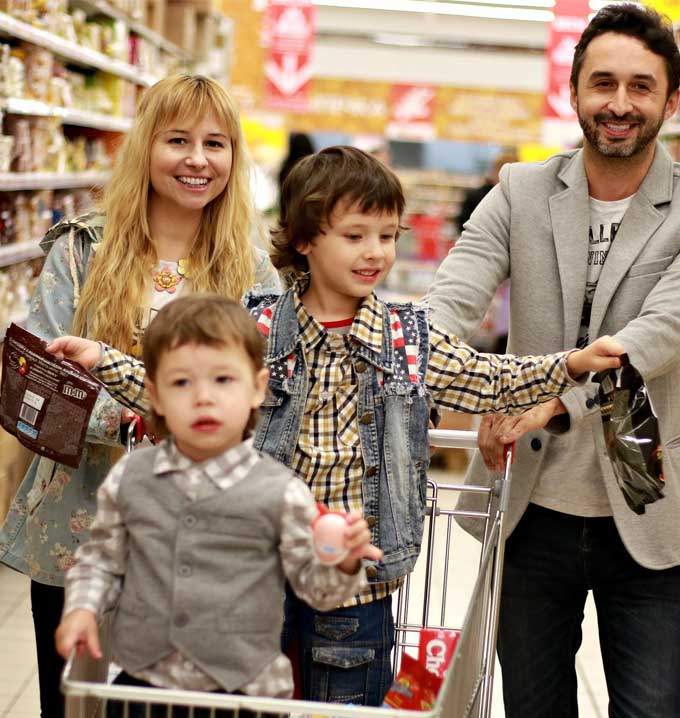Tips for Shopping With Autistic Children in Overstimulating Environments
The grocery store can be an overwhelming experience for autistic children. Here are tips for shopping with autistic children in overstimulating environments.

Autism-Friendly Shopping Tips for Overstimulating Environments
Everyday shopping, such as in a grocery store, might seem like a pretty straightforward experience to most, but for autistic children, it can be seriously overwhelming. Grocery stores are prime candidates for sensory overload, with bright lights, music, people, shopping carts, vegetable misters, and beeping registers all adding to what might already be a stressful outing.
The way you approach everyday shopping can make a world of difference for you and your child. It does require some preparation, but it goes a long way to relieve undue stress. Of course, it is important to learn the signs of overstimulation with autism so that you can react in the right way, but by preparing yourself and your child for everyday shopping experiences, you will hopefully prevent any overstimulation from the start.
Here are some helpful tips for sensory overload and how to avoid it when shopping.
1. Be Proactive: Think About Your Child’s Sensory Experiences
It’s better to anticipate potential triggers than to hope for the best. Think about the elements that could cause your child distress. If you identify and understand these triggers, you can either help your child avoid them or create a plan to manage the situations that could lead to sensory overload. By thinking ahead, you can discover how to avoid sensory overload. Are the noises an issue? Bring headphones. Do they like touching everyone? Bring fidgets in the store with you.
2. Stay Organized
You can start with a written schedule and a visual checklist for your child to follow along with. If you are organized, the shopping trip can proceed much more smoothly. While you might enjoy a trip to the mall and browsing for hours, limiting your time in the shops and getting only what you came for will help keep your child from feeling overwhelmed. Ensure that you write down what you need and get to those things and out of the store as quickly as you can. Think about going in order of the isles in a store you know and ensuring you aren’t running around the store.
3. Make Multiple Shorter Tips to the Shops
If you’ve got a huge list of things to buy, it might be best to do it in little bits rather than in one go. So, instead of doing one big monthly shop, perhaps split it into weekly visits. This makes each shopping experience shorter and also gets your child used to visiting the grocery store and learning an important life skill that they will need in the future.
4. Look for a Quiet Zone
It’s beneficial to know how to deal with overstimulation in autism while shopping. For instance, find a quiet zone so that your child can catch a breather from the busy areas. Look for a less populated area in the shop and know this spot before you get there with your child. This will help if your child is experiencing sensory overload or is uncomfortable in any way.
5. Bring a Sensory Toolkit
A sensory kit can provide comfort while shopping. You could pack sensory items such as fidget toys, a favorite blanket, and headphones. The sensory kit can also help with self-regulation. Fidget spinners or soft toys can actually provide a comforting touch and promote a sense of security.
6. Choose Stores Wisely
Do some research on shops that prioritize inclusivity and understand the unique needs of autistic children. Look for stores that have a reputation for creating sensory-friendly environments. These environments could include softer lighting, well-organized spaces, and quieter atmospheres. Some stores have special carts for kids (and adults) with disabilities that help to contain them and keep them comfortable.
7. Set Realistic Expectations
Realistic expectations are crucial for creating a positive experience. When you recognize that unexpected factors may influence your child’s behavior, you can be flexible in these situations and adjust accordingly. It is important to communicate with your child about the upcoming shopping trip: remember to use visual support or social stories to set expectations. Social stories are short descriptions of everyday situations that are depicted visually; you can run through them with your child before an activity or event in order to make it a less stressful experience for them.
A good idea would be to break down the shopping excursion into manageable steps. If you’re open to embracing the possibility of minor challenges and seeing them as opportunities for growth, it could end up being a positive experience.
8. Celebrate Small Victories
Be on the lookout for small victories that you can acknowledge and celebrate with your child and reinforce their efforts. This will establish a positive and supportive environment. Completing a shopping task should never be prioritized over your child’s well-being. Sometimes a successful trip to the store means getting one item and leaving on a positive note.
9. Use Reinforcement and Praise
Using positive reinforcement is an excellent way to make the shopping experience more pleasant for your child. Set small goals. Perhaps you could set a ten-minute timer and reward your child with a token after every ten minutes. They can then use their tokens to ‘buy’ something before you leave the store or exchange them for a reward when you get home.
Don’t forget to praise your child when they do well at the store, too. This means that they feel comfortable in their environment, or they use healthy coping mechanisms that they have learned to get through the shopping experience. It’s important to remember that this can be an extremely overwhelming experience for them, so visual praise will go a long way to creating a more positive experience for you both.
Lighthouse Autism Center
Dealing with autism overstimulation during a shopping trip requires a combination of understanding, preparation, and supportive strategies.
Speaking to an autism specialist can guide you on the best choices to make for your autistic child. At Lighthouse Autism Center, we have programs such as Lighthouse Fusion ABA Therapy to assist both parents and their autistic children. Our autism tools for parents can help to relieve the stress that can come with shopping.
Together, we can unlock your child’s potential
Related News

11/18/2025
Tips for Picky Eaters and Introducing New Foods
Autistic children are often labeled as picky eaters, but the truth is that they face a unique set of challenges that can make mealtimes extremely stressful. Discover helpful tips on introducing new foods into your child’s diet to make mealtimes more nutritional and enjoyable for everyone at the table. Autism and Food: Tips for Introducing […]

11/14/2025
Exploring the Beauty of Fall Through Sensory Play
As the weather cools off and the leaves start to change colors, fall offers a perfect opportunity for children to explore nature with all their senses. For children with autism, spending time outdoors can be calming, grounding, and full of rich sensory learning experiences. From the crunchy leaves to the smell of pine and feel […]

10/28/2025
Choosing Gifts for an Autistic Child
Choosing a gift for a loved one is rarely simple, and for parents of autistic children, this process can be even more challenging. Choosing gifts for autistic kids requires extra thought about not just the child’s interests, but also understanding their sensory needs and how they communicate what they may want. But, with a bit […]


